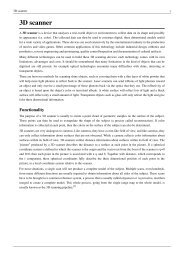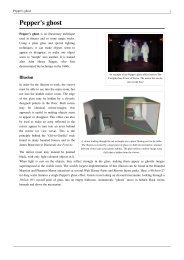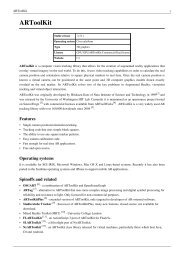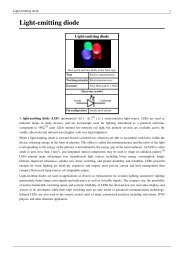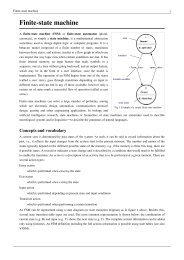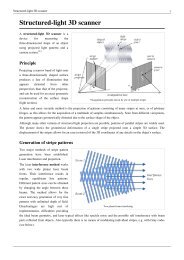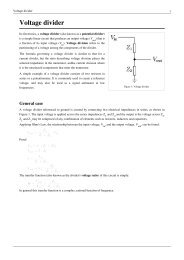LIDAR - Wikipedia, the free encyclopedia.pdf - Ex-ch.com
LIDAR - Wikipedia, the free encyclopedia.pdf - Ex-ch.com
LIDAR - Wikipedia, the free encyclopedia.pdf - Ex-ch.com
Create successful ePaper yourself
Turn your PDF publications into a flip-book with our unique Google optimized e-Paper software.
<strong>LIDAR</strong> 2<br />
scattering as well as fluorescence. Based on different kinds of backscattering, <strong>the</strong> <strong>LIDAR</strong> can be accordingly called<br />
Rayleigh LiDAR, Mie LiDAR, Raman LiDAR and Na/Fe/K Fluorescence <strong>LIDAR</strong> and so on. The wavelengths are<br />
ideal for making measurements of smoke and o<strong>the</strong>r airborne particles (aerosols), clouds, and air molecules [1] .<br />
A laser typically has a very narrow beam whi<strong>ch</strong> allows <strong>the</strong> mapping of physical features with very high resolution<br />
<strong>com</strong>pared with radar. In addition, many <strong>ch</strong>emical <strong>com</strong>pounds interact more strongly at visible wavelengths than at<br />
microwaves, resulting in a stronger image of <strong>the</strong>se materials. Suitable <strong>com</strong>binations of lasers can allow for remote<br />
mapping of atmospheric contents by looking for wavelength-dependent <strong>ch</strong>anges in <strong>the</strong> intensity of <strong>the</strong> returned<br />
signal.<br />
<strong>LIDAR</strong> has been used extensively for atmospheric resear<strong>ch</strong> and meteorology. With <strong>the</strong> deployment of <strong>the</strong> GPS in <strong>the</strong><br />
1980s precision positioning of aircraft became possible. GPS based surveying te<strong>ch</strong>nology has made airborne<br />
surveying and mapping applications possible and practical. Many have been developed, using downward-looking<br />
<strong>LIDAR</strong> instruments mounted in aircraft or satellites. A recent example is <strong>the</strong> NASA <strong>Ex</strong>perimental Advanced<br />
Resear<strong>ch</strong> Lidar. [2]<br />
Design<br />
In general <strong>the</strong>re are two kinds of lidar detection s<strong>ch</strong>ema: "incoherent" or direct energy detection (whi<strong>ch</strong> is principally<br />
an amplitude measurement) and Coherent detection (whi<strong>ch</strong> is best for doppler, or phase sensitive measurements).<br />
Coherent systems generally use Optical heterodyne detection whi<strong>ch</strong> being more sensitive than direct detection allows<br />
<strong>the</strong>m to operate a mu<strong>ch</strong> lower power but at <strong>the</strong> expense of more <strong>com</strong>plex transceiver requirements.<br />
In both coherent and incoherent <strong>LIDAR</strong>, <strong>the</strong>re are two types of pulse models: micropulse lidar systems and high<br />
energy systems. Micropulse systems have developed as a result of <strong>the</strong> ever increasing amount of <strong>com</strong>puter power<br />
available <strong>com</strong>bined with advances in laser te<strong>ch</strong>nology. They use considerably less energy in <strong>the</strong> laser, typically on<br />
<strong>the</strong> order of one microjoule, and are often "eye-safe," meaning <strong>the</strong>y can be used without safety precautions.<br />
High-power systems are <strong>com</strong>mon in atmospheric resear<strong>ch</strong>, where <strong>the</strong>y are widely used for measuring many<br />
atmospheric parameters: <strong>the</strong> height, layering and densities of clouds, cloud particle properties (extinction coefficient,<br />
backscatter coefficient, depolarization), temperature, pressure, wind, humidity, trace gas concentration (ozone,<br />
methane, nitrous oxide, etc.) [1] .<br />
There are several major <strong>com</strong>ponents to a <strong>LIDAR</strong> system:<br />
1. Laser — 600-1000 nm lasers are most <strong>com</strong>mon for non-scientific applications. They are inexpensive but since<br />
<strong>the</strong>y can be focused and easily absorbed by <strong>the</strong> eye <strong>the</strong> maximum power is limited by <strong>the</strong> need to make <strong>the</strong>m<br />
eye-safe. Eye-safety is often a requirement for most applications. A <strong>com</strong>mon alternative 1550 nm lasers are<br />
eye-safe at mu<strong>ch</strong> higher power levels since this wavelength is not focused by <strong>the</strong> eye, but <strong>the</strong> detector te<strong>ch</strong>nology<br />
is less advanced and so <strong>the</strong>se wavelengths are generally used at longer ranges and lower accuracies. They are also<br />
used for military applications as 1550 nm is not visible in night vision goggles unlike <strong>the</strong> shorter 1000 nm<br />
infrared laser. Airborne topographic mapping lidars generally use 1064 nm diode pumped YAG lasers, while<br />
bathymetric systems generally use 532 nm frequency doubled diode pumped YAG lasers because 532 nm<br />
penetrates water with mu<strong>ch</strong> less attenuation than does 1064 nm. Laser settings include <strong>the</strong> laser repetition rate<br />
(whi<strong>ch</strong> controls <strong>the</strong> data collection speed). Pulse length is generally an attribute of <strong>the</strong> laser cavity length, <strong>the</strong><br />
number of passes required through <strong>the</strong> gain material (YAG, YLF, etc.), and Q-swit<strong>ch</strong> speed. Better target<br />
resolution is a<strong>ch</strong>ieved with shorter pulses, provided <strong>the</strong> <strong>LIDAR</strong> receiver detectors and electronics have sufficient<br />
bandwidth [1] .<br />
2. Scanner and optics — How fast images can be developed is also affected by <strong>the</strong> speed at whi<strong>ch</strong> it can be<br />
scanned into <strong>the</strong> system. There are several options to scan <strong>the</strong> azimuth and elevation, including dual oscillating<br />
plane mirrors, a <strong>com</strong>bination with a polygon mirror, a dual axis scanner. Optic <strong>ch</strong>oices affect <strong>the</strong> angular<br />
resolution and range that can be detected. A hole mirror or a beam splitter are options to collect a return signal.








